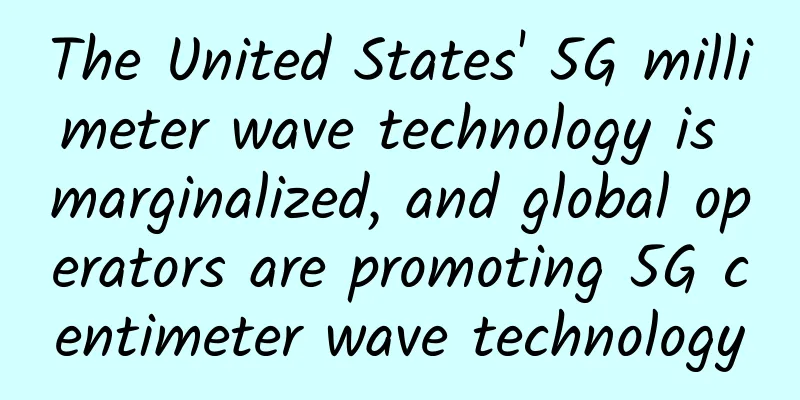The United States' 5G millimeter wave technology is marginalized, and global operators are promoting 5G centimeter wave technology

|
There are two technical standards for 2G and three technical standards for 3G. The coexistence of multiple technical standards has led to excessively high costs for operators and the mobile phone industry chain, and is also not conducive to interoperability. Therefore, the International Standards Organization has been pushing for unified mobile communication technology standards. Although 4G and 5G claim to have adopted a unified technical standard globally, there are still subdivisions. 4G has TD-LTE and LTE-FDD technologies. TD-LTE technology is mainly commercialized in the Chinese market. The global mainstream 4G technology standard is LTE-FDD. 5G is subdivided into 5G centimeter wave technology and 5G millimeter wave technology. China and Europe are mainly promoting 5G centimeter wave technology. The reason why China and Europe adopt unified technical standards in 5G technology is that they have established a close cooperative relationship through their concerted efforts in 4G technology. At that time, China and Europe vigorously promoted LTE technology, while the United States launched UMB and wimax technologies respectively. In the end, the LTE technology jointly developed by China and Europe defeated the UMB and wimax technologies of the United States. Naturally, based on their interests, China and Europe cooperated in 5G technology to develop 5G centimeter wave technology.
The United States lost the battle for 4G technology standards, causing American companies to lose too much profit. In order to continue its patent fee charging model, Qualcomm in the United States required that 2G/3G/4G patents be bundled and charged. With the commercialization of 5G technology, it is no longer realistic to continue bundling 2G and 3G. In order to ensure the interests of American companies, the United States developed 5G millimeter wave technology based on 5G technology standards, trying to gain 5G patent advantages. Another major reason why the United States developed 5G millimeter wave technology is that the Sub-6 frequency band used by operators outside the United States is occupied by the US military. US operators have no choice but to use the 28-60GHz high frequency band to build 5G networks, which forced the United States to develop 5G millimeter wave technology. The development of 5G millimeter wave technology in the United States has caused great suffering to American operators. Due to the very weak diffraction and diffraction capabilities of 5G millimeter wave technology, the coverage radius of 5G base stations is only about 200 meters. In this way, the construction of 5G networks will require dense construction of 5G base stations. The construction cost of 5G networks is relatively high. The cost of using 5G millimeter wave technology to build 5G networks is even higher. As a result, American operators have not yet built 5G networks on a large scale. American operator Verizon uses 5G technology to provide 5G fixed-line broadband services instead of 5G mobile communication services. The powerful US operators are reluctant to adopt 5G millimeter wave technology on a large scale. Naturally, other operators around the world are even less willing to adopt the expensive 5G millimeter wave technology. In the end, as mentioned at the beginning of this article, only four operators in the United States and one operator in Uruguay adopted 5G millimeter wave technology. The United States has also recognized the shortcomings of 5G millimeter wave technology. It is providing more than $10 billion to compensate U.S. satellite communication companies to allow them to release the Sub-6 frequency band. As the United States releases the Sub-6 frequency band, U.S. operators will also switch to 5G centimeter wave technology. Even the United States, which has been pushing for 5G millimeter wave technology, has realized the drawbacks of the technology and may give up on it. It is even less likely that operators outside the United States will adopt 5G millimeter wave technology. In this way, the marginalization of 5G millimeter wave technology is a foregone conclusion, and 5G centimeter wave technology has completely won. |
<<: iPhone 12 is coming! What else is there to look forward to besides the new phone?
Recommend
5G Downlink Channel Sounding "CSI-RS"
Since 4G, the bandwidth of carriers has increased...
Huawei Telnet and Stelnet login methods that make people dizzy
I am Zhao Jiexu, a lecturer at 51CTO Academy. On ...
The development of 4G proves that there is no need to wait for 5G to mature before commercial deployment
It is too early for China Mobile to advance its 5...
ACI's "hardcore security" is more eye-catching
[51CTO.com original article] According to market ...
Comprehensive Anatomy of Data Center Facility Planning and IT Operations Checklist
Making the right choices in terms of data center ...
VPSSLIM: €12.95/year Netherlands VPS - 1GB/10GB/10Gbps ports with unlimited traffic
VPSSLIM is a foreign hosting company registered i...
Forecast of cellular network development trends in 2017
[[183195]] The new year of 2017 will continue the...
The cutting-edge of Internet technology - a comprehensive analysis of TSN
[[271597]] TSN is the abbreviation of time-sensit...
OpLink: Houston 1Gbps unlimited traffic high-security VPS starting at $1 for the first month
Tribe has shared information about OpLink twice i...
China Unicom's mixed ownership reform is the trigger for the restructuring of the telecommunications industry order
How will China Mobile and China Telecom respond t...
Gateway programming: How to reduce R&D costs through user gateways and caches?
If the user's traffic is like the surging wav...
Understand 3GPP 5G versions and the features of each version
While for years cellular technology has been prim...
TMThosting: Seattle high-security VPS with 20% off for monthly payment, 30% off for annual payment, China Unicom CUVIP line, Alipay support
It has been a while since I shared information ab...
The impact of blockchain technology on the future world and data centers
As organizations gain a deeper understanding of t...
RackNerd Easter promotion starts at $10.78/year, multiple data centers in Seattle/New York/Dallas, etc.
I just shared the summary of RackNerd's histo...









